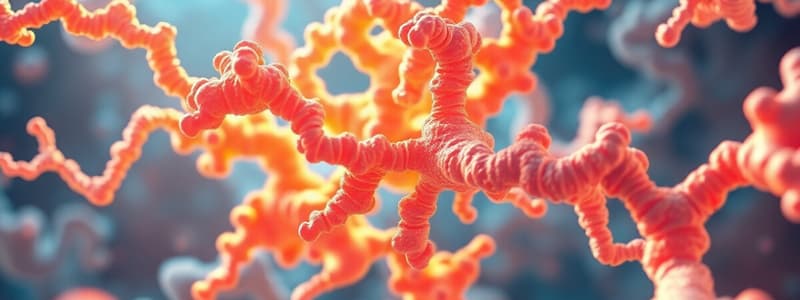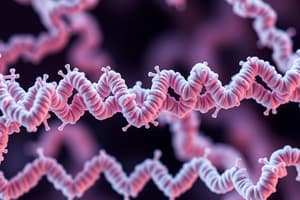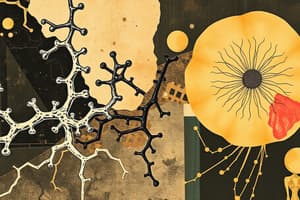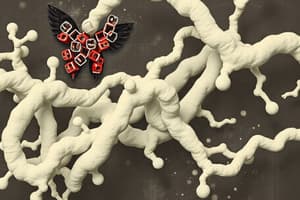Podcast
Questions and Answers
Which characteristic primarily defines fibrous proteins?
Which characteristic primarily defines fibrous proteins?
- They are typically soluble in water.
- They are catalytic enzymes.
- They are structural elements and insoluble. (correct)
- They have a spherical shape.
Which of the following is a function of collagen?
Which of the following is a function of collagen?
- To act as a catalyst in metabolic reactions.
- To regulate gene expression.
- To provide structural support to tissues. (correct)
- To transport oxygen in the blood.
Which structural feature is characteristic of a collagen molecule?
Which structural feature is characteristic of a collagen molecule?
- A single alpha helix
- A quaternary structure with multiple subunits
- A triple helix formed by three polypeptide chains (correct)
- A beta-pleated sheet
How are the polypeptide chains in a collagen molecule held together?
How are the polypeptide chains in a collagen molecule held together?
What determines the specific type and organization of collagen in a particular organ?
What determines the specific type and organization of collagen in a particular organ?
Which amino acids are particularly abundant in collagen's structure?
Which amino acids are particularly abundant in collagen's structure?
What post-translational modification contributes to the stabilization of the triple helical structure of collagen?
What post-translational modification contributes to the stabilization of the triple helical structure of collagen?
What role does proline play in the structure of collagen?
What role does proline play in the structure of collagen?
Where does hydroxylation of proline and lysine occur during collagen synthesis?
Where does hydroxylation of proline and lysine occur during collagen synthesis?
What is the role of glycosylation during collagen synthesis?
What is the role of glycosylation during collagen synthesis?
Which of the following is a necessary cofactor for the enzymes involved in the hydroxylation of proline and lysine?
Which of the following is a necessary cofactor for the enzymes involved in the hydroxylation of proline and lysine?
In what cellular compartment are pro-alpha chains synthesized during collagen synthesis?
In what cellular compartment are pro-alpha chains synthesized during collagen synthesis?
What is the role of fibroblasts in collagen synthesis?
What is the role of fibroblasts in collagen synthesis?
Which process is essential for forming collagen fibers after enzymatic modification of collagen monomers?
Which process is essential for forming collagen fibers after enzymatic modification of collagen monomers?
Which step in collagen synthesis involves procollagen peptidases?
Which step in collagen synthesis involves procollagen peptidases?
Which enzyme catalyzes the formation of covalent cross-links in collagen?
Which enzyme catalyzes the formation of covalent cross-links in collagen?
Why is cross-linking important in mature collagen?
Why is cross-linking important in mature collagen?
Under normal physiological conditions, what primarily degrades collagen fibers?
Under normal physiological conditions, what primarily degrades collagen fibers?
Vitamin C deficiency leads to scurvy because it impairs:
Vitamin C deficiency leads to scurvy because it impairs:
What is the primary defect in patients with Ehlers-Danlos Syndrome (EDS)?
What is the primary defect in patients with Ehlers-Danlos Syndrome (EDS)?
A patient presents with hypermobile joints and highly extensible skin. Which type of collagen is most likely affected in this individual?
A patient presents with hypermobile joints and highly extensible skin. Which type of collagen is most likely affected in this individual?
What is the underlying cause of osteogenesis imperfecta (OI)?
What is the underlying cause of osteogenesis imperfecta (OI)?
Which amino acid substitution is most common in severe cases of osteogenesis imperfecta (OI)?
Which amino acid substitution is most common in severe cases of osteogenesis imperfecta (OI)?
What property characterizes elastin?
What property characterizes elastin?
What is the precursor molecule for elastin?
What is the precursor molecule for elastin?
Which amino acids are abundant in elastin?
Which amino acids are abundant in elastin?
What unique cross-link is found in elastin that contributes to its elasticity?
What unique cross-link is found in elastin that contributes to its elasticity?
What glycoprotein acts as a scaffold onto which tropoelastin is deposited in the extracellular space?
What glycoprotein acts as a scaffold onto which tropoelastin is deposited in the extracellular space?
Mutation in which protein leads to Marfan Syndrome?
Mutation in which protein leads to Marfan Syndrome?
Which of the following is a key function of $\alpha_1$-antitrypsin?
Which of the following is a key function of $\alpha_1$-antitrypsin?
What is the primary effect of $\alpha_1 \text{ -antitrypsin}$ deficiency in the lungs?
What is the primary effect of $\alpha_1 \text{ -antitrypsin}$ deficiency in the lungs?
What condition can result from a genetic defect in $\alpha_1$-antitrypsin (AAT)?
What condition can result from a genetic defect in $\alpha_1$-antitrypsin (AAT)?
How does smoking contribute to the inactivation of $\alpha_1$-antitrypsin (AAT)?
How does smoking contribute to the inactivation of $\alpha_1$-antitrypsin (AAT)?
Which modification is required in AAT for the binding of the inhibitor to its target proteases?
Which modification is required in AAT for the binding of the inhibitor to its target proteases?
A patient with bruising on the limbs, capillary fragility and decreased formation of a stable triple helix likely has what disease?
A patient with bruising on the limbs, capillary fragility and decreased formation of a stable triple helix likely has what disease?
Skin extensibility and mobile joints is likely a sign of what disease?
Skin extensibility and mobile joints is likely a sign of what disease?
Defects in which collagen type is the classic form of Ehlers-Danlos Syndrome?
Defects in which collagen type is the classic form of Ehlers-Danlos Syndrome?
Fragile bones that breakdown easily is a sign of which disease?
Fragile bones that breakdown easily is a sign of which disease?
Glycine constitutes every third position of the polypeptide chain in what?
Glycine constitutes every third position of the polypeptide chain in what?
What is the purpose of prolyl and lysyl hydroxylase?
What is the purpose of prolyl and lysyl hydroxylase?
How is tropocollagen produced?
How is tropocollagen produced?
A mutation in the gene for fibrillin is a descriptor for what disease?
A mutation in the gene for fibrillin is a descriptor for what disease?
Which of the following contributes to the stabilization of the collagen triple helix structure?
Which of the following contributes to the stabilization of the collagen triple helix structure?
What is the consequence of lysine to glutamic acid substitution at position 342 in alpha-1 antitrypsin?
What is the consequence of lysine to glutamic acid substitution at position 342 in alpha-1 antitrypsin?
Collagen, elastin, keratin and fibroin share a common characteristic as:
Collagen, elastin, keratin and fibroin share a common characteristic as:
The formation of desmosine cross-links plays a crucial role in which of the following proteins?
The formation of desmosine cross-links plays a crucial role in which of the following proteins?
Which group of collagens are the fibrillar collagens?
Which group of collagens are the fibrillar collagens?
Which of the following is the function of fibrillin in relation to elastin?
Which of the following is the function of fibrillin in relation to elastin?
What level of protein structure is considered when describing fibrous proteins?
What level of protein structure is considered when describing fibrous proteins?
What type of collagen forms the 'network-forming' group?
What type of collagen forms the 'network-forming' group?
What is the role of procollagen peptidases in collagen synthesis?
What is the role of procollagen peptidases in collagen synthesis?
Why is Vitamin C important?
Why is Vitamin C important?
What is required for the binding of the inhibitor to its target proteases within alpha-1 antitrypsin?
What is required for the binding of the inhibitor to its target proteases within alpha-1 antitrypsin?
What enzyme is directly responsible for the breakdown of collagen fibers in the body?
What enzyme is directly responsible for the breakdown of collagen fibers in the body?
What is the purpose of the enzyme lysyl oxidase?
What is the purpose of the enzyme lysyl oxidase?
Connective tissue is made up of which of the following?
Connective tissue is made up of which of the following?
Flashcards
Fibrous Proteins
Fibrous Proteins
Structural elements that are usually insoluble, found in skin, connective tissue, blood vessels, sclera, cornea.
Collagen
Collagen
The most abundant protein in the human body (~25-35% of total body protein), providing strength to tendons and support to extracellular matrix.
Types of Collagen
Types of Collagen
A collagen superfamily consisting of more than twenty-five types with varying properties.
Fibril-forming Collagens
Fibril-forming Collagens
Signup and view all the flashcards
Network Forming Collagens
Network Forming Collagens
Signup and view all the flashcards
Fibril Associated Collagens
Fibril Associated Collagens
Signup and view all the flashcards
Structure of Collagen
Structure of Collagen
Signup and view all the flashcards
Collagen's Amino Acid Sequence
Collagen's Amino Acid Sequence
Signup and view all the flashcards
Glycosylation of Collagen
Glycosylation of Collagen
Signup and view all the flashcards
Hydroxylation of Collagen
Hydroxylation of Collagen
Signup and view all the flashcards
Collagen Biosynthesis
Collagen Biosynthesis
Signup and view all the flashcards
Hydroxylase
Hydroxylase
Signup and view all the flashcards
Assembly and Secretion
Assembly and Secretion
Signup and view all the flashcards
Degradation of Collagen
Degradation of Collagen
Signup and view all the flashcards
Scurvy
Scurvy
Signup and view all the flashcards
Ehlers-Danlos Syndrome (EDS)
Ehlers-Danlos Syndrome (EDS)
Signup and view all the flashcards
Osteogenesis Imperfecta (OI)
Osteogenesis Imperfecta (OI)
Signup and view all the flashcards
Elastin
Elastin
Signup and view all the flashcards
Structure of Elastin
Structure of Elastin
Signup and view all the flashcards
tropoelastin
tropoelastin
Signup and view all the flashcards
Marfan Syndrome
Marfan Syndrome
Signup and view all the flashcards
α₁-Antitrypsin
α₁-Antitrypsin
Signup and view all the flashcards
Role of a₁-antitrypsin In The Lungs
Role of a₁-antitrypsin In The Lungs
Signup and view all the flashcards
Study Notes
- Fibrous proteins, including collagen, elastin, keratin, and fibroin, are structural elements.
- Fibrous proteins generally are insoluble, and are found only in animals
- Fibrous proteins are key components of skin, connective tissue, blood vessels, and the eye covering
Collagen
- Collagen is the most abundant protein in the human body, accounting for 25-35% of total body protein.
- It is a glycoprotein that contains galactose and glucose
- Collagen molecules exhibit a long, rigid structure consisting of three polypeptides (alpha chains) twisted together into a rope-like triple helix.
- Collagen can be bundled into tight, parallel fibers for strength or dispersed as a gel for structural support
- There are more than twenty-five types of collagen
- Types I, II, and III form rope-like structures
- Types IV and VII form a three-dimensional mesh
- Types IX and XII link collagen fibrils to each other and other extracellular matrix components.
- Collagen's structure is defined by a triple-helical arrangement with amino acid side chains located on the molecule's surface.
- It is rich in proline and glycine, which are important in forming the triple-stranded helix.
- Proline facilitates helix formation, thanks to its ring structure that causes 'kinks' in the peptide chain.
- Glycine is in every third position of the polypeptide chain
- The amino acid sequence is defined by Gly-X-Y
- X is frequently proline and Y is hydroxylysine or hydroxy lysine
- The hydroxyl group of hydroxylysine residues may be enzymatically glycosylated.
- Glucose and galactose are commonly attached to the polypeptide chain prior to triple helix formation.
- Collagen contains hydroxyproline (hyp) and hydroxylysine (hyl), which are not found in most other proteins
Collagen Biosynthesis
- Polypeptide precursors of collagen are synthesized in fibroblasts then secreted into the extracellular matrix
- The biosynthesis follows these steps:
- Formation of pro-α chains in the RER
- Hydroxylation in the ER cisternae requiring O2, Fe2+, and vitamin C
- Glycosylation in the ER
- Assembly and coiling in the Golgi apparatus
- Extracellular cleavage of Procollagen molecules
- Formation of collagen fibrils
- Cross-link formation
- Hydroxylase enzymes in the ER cisternae add hydroxyl groups to some prolines and lysines requiring O2, Fe2+, and Vitamin C
Collagen Degradation
- Normal collagens are highly stable with half-lives that can be several years.
- Degradation of fibers is dependent on collagenases, found in the matrix metalloproteinases family
Collagenopathies
- Scurvy is a disease caused by vitamin C deficiency, impairing interchain H-bond formation and cross-linking of collagen fibrils.
- Results in easy bruising
- Ehlers-Danlos Syndrome (EDS) is a group of connective tissue disorders with defects in fibrillar collagen metabolism.
- The classic form of EDS causes skin extensibility and joint hypermobility
- Osteogenesis Imperfecta (OI) is a group of inherited disorders also known as brittle bone syndrome
- OI is often caused by mutations in the gene for type I collagen, leading to bones that easily bend and fracture
Elastin
- Elastin, a connective tissue protein, has rubber-like properties.
- Elastic fibers, composed of elastin and glycoprotein microfibrils, are found in lungs, large arteries, and elastic ligaments.
- Elastin can stretch several times its normal length and recoil to its original shape, consisting of tropoelastin.
- It is rich in proline and lysine but has only small amounts of hydroxyproline and hydroxylysine.
- Tropoelastin, secreted into the extracellular space, interacts with glycoprotein microfibrils like fibrillin to form elastin
- Lysyl oxidase then forms allysine residues from the lysyl side chains of tropoelastin polypeptides.
- Desmosine cross-links connect three allysyl side chains plus one unaltered lysyl side chain from the same or neighboring polypeptides.
- Mutations in the fibrillin gene can cause Marfan Syndrome
α₁-Antitrypsin in Elastin Degradation
- α₁-Antitrypsin inhibits neutrophil elastase, which degrades elastin in alveolar walls.
- Genetic defects in α₁-antitrypsin (AAT) can lead to emphysema and cirrhosis.
- A single purine base mutation (GAG-AAG) in the α₁ antitrypsin gene causes a substitution of lysine for glutamic acid at position 342, is the most widespread
α₁-Antitrypsin Role in Lungs
- In lungs, degenerating neutrophils normally degrade elastase by activation of AAT
- Methionine 358 in α₁-antitrypsin is essential for binding to target proteases.
- Smoking causes oxidation of methionine residue, rendering the inhibitor powerless to neutralize elastase.
Studying That Suits You
Use AI to generate personalized quizzes and flashcards to suit your learning preferences.




